生态安全格局与国土空间开发格局优化
国土空间开发格局
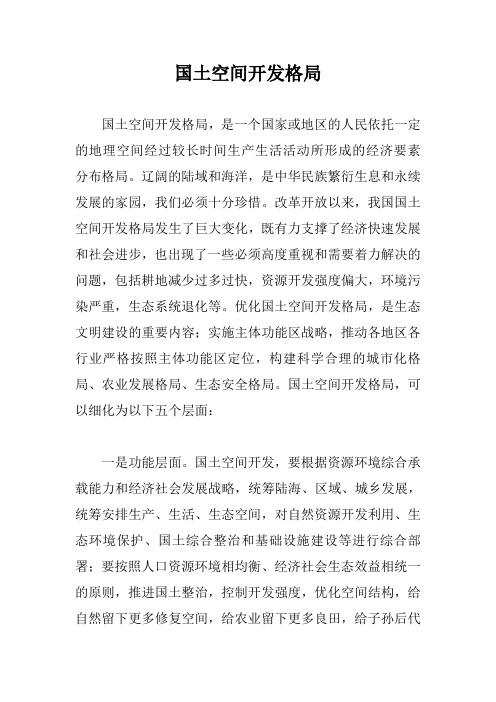
国土空间开发格局国土空间开发格局,是一个国家或地区的人民依托一定的地理空间经过较长时间生产生活活动所形成的经济要素分布格局。
辽阔的陆域和海洋,是中华民族繁衍生息和永续发展的家园,我们必须十分珍惜。
改革开放以来,我国国土空间开发格局发生了巨大变化,既有力支撑了经济快速发展和社会进步,也出现了一些必须高度重视和需要着力解决的问题,包括耕地减少过多过快,资源开发强度偏大,环境污染严重,生态系统退化等。
优化国土空间开发格局,是生态文明建设的重要内容;实施主体功能区战略,推动各地区各行业严格按照主体功能区定位,构建科学合理的城市化格局、农业发展格局、生态安全格局。
国土空间开发格局,可以细化为以下五个层面:一是功能层面。
国土空间开发,要根据资源环境综合承载能力和经济社会发展战略,统筹陆海、区域、城乡发展,统筹安排生产、生活、生态空间,对自然资源开发利用、生态环境保护、国土综合整治和基础设施建设等进行综合部署;要按照人口资源环境相均衡、经济社会生态效益相统一的原则,推进国土整治,控制开发强度,优化空间结构,给自然留下更多修复空间,给农业留下更多良田,给子孙后代留下天蓝、地绿、水净的美好家园,实现生产空间集约高效、生活空间宜居适度、生态空间山清水秀。
二是区域层面。
要树立协调发展理念,推进多规合一。
国土空间规划对区域规划、土地规划、城乡规划等空间规划及相关专项规划具有综合性、基础性、战略性和约束性作用,应以重点开发促面上保护,在发展中保护,在保护在发展,实施点轴集聚式开发,辐射带动区域发展;扶持落后地区加快发展、提升自我发展能力,缩小区域差距;推进交通通讯、供水供气、环境保护等基础设施建设,促进基本公共服务均等化。
三是城乡层面。
要树立共享发展理念,坚持走新型城镇化和城乡一体化发展道路,优化发展和重点培育城市群,加快特色小镇建设,促进大中小城市和小城镇协调发展,增强城镇吸纳人口能力,解决三个“约一个亿”人口问题;促进城乡要素平等交换和公共资源均衡配置,以城带乡,实现城乡基础设施、产业发展、就业保障、环境保护一体化建设、协调发展。
“十五五”时期我国生态地区的战略格局与优化

专题:“十五五”区域协调发展与国土空间发展格局优化Coordinated Regional Development and Territorial Spatial Optimization in 15th Five-Year Plan引用格式:周侃, 樊杰, 周道静, 等. “十五五”时期我国生态地区的战略格局与优化. 中国科学院院刊, 2024, 39(4): 676-688, doi: 10.16418/j.issn.1000-3045.20240319003.Zhou K, Fan J, Zhou D J, et al. Strategic pattern and optimization of China’s eco-regions during Fifteenth Five-Year Plan period. Bulletin of Chinese Academy of Sciences, 2024, 39(4): 676-688, doi: 10.16418/j.issn.1000-3045.20240319003. (in Chinese)“十五五”时期我国生态地区的战略格局与优化周侃1,2*樊杰1,2,3周道静3*钱者东4虞虎1,2,3刘汉初3张健1,21 中国科学院地理科学与资源研究所中国科学院区域可持续发展分析与模拟重点实验室北京1001012 中国科学院大学资源与环境学院北京1000493 中国科学院科技战略咨询研究院北京1001904 生态环境部南京环境科学研究所南京210042摘要自主体功能区规划实施以来,重点生态功能区生态空间持续扩张、植被覆盖显著增加,人口呈总量减少、城镇人口增加双向变化,经济社会发展取得显著成效,生态安全屏障功能稳步提升、人地关系紧张状态总体缓解。
“十五五”时期,坚持以提供生态服务或生态产品为主的功能定位,稳固生态系统供给、调节、支持及文化服务规模;同时,更加注重其服务质量提升,形成更具多样性、稳定性、可持续性的生态基底,并兼容绿色化、低碳化的生态产品开发利用功能,形成推进人与自然和谐共生现代化的包容性保护方式。
优化国土空间开发保护格局的思路与建议

优化国土空间开发保护格局的思路与建议十八大以来,中国国土空间开发保护取得了显著成效,但同时也存在一些结构性矛盾和问题。
“十四五”时期,须加快完善空间治理体系、提升空间治理能力,妥善解决国土空间开发保护面临的突出问题和挑战,在深入落实国家生态文明、美丽中国建设战略部署的同时,加快推进国土空间实现高质量发展。
一、十八大以来中国国土空间开发保护取得的主要成效(一)以主体功能区为基础的国土空间开发保护战略架构初步搭建。
主体功能区建设是在全国国土空间规划缺位的特定历史背景下提出的国土空间开发保护战略部署,目前作为国土空间开发保护的基础制度初步确立,已基本形成以“两横三纵”为主体的城镇化格局、以“七区二十三带”为主体的农业生产格局、以“两屏三带”为主体的生态安全格局等三大空间战略格局,初步搭建起国土空间开发保护格局的总体战略架构,对中国国土空间开发保护发挥了重要引领作用。
目前,不同类型空间的主体功能已开始显现,对优化人口、经济和资源配置,推动形成要素有序自由流动、基本公共服务均等化发挥了积极的引导作用。
(二)多中心、网络化、开放式的区域开发格局逐渐明晰。
十八大以来,随着外向型经济和非公有经济的不断拉动,中国人口、产业向东部沿海和大城市集聚的态势不断增强。
京津、江浙沪、闽粤等主要东部沿海省区经济增长长期处于高值区域。
2018年东部地区人口、GDP分别占比全国29.59%和44.20%,而东部地区内部也分异明显,人口及主要的经济份额向东南大城市地区加速集聚。
京津冀、长三角、粤港澳等三大世界级城市群作为核心引擎继续发力;与此同时,成渝、武汉、中原、长株潭、山东半岛、海峡西岸等城市群的集聚发展和辐射带动能力持续增强。
以京津冀、长三角、珠三角、成渝四大核心城市群为战略增长极,以“一带一路”带动下的沿海、沿江、沿边、沿主要交通干线为主要开发轴带,多中心、网络化、开放式的区域开发格局逐渐明晰。
(三)以生态文明和可持续发展为导向的农业发展布局不断优化。
国土空间规划与生态安全保障
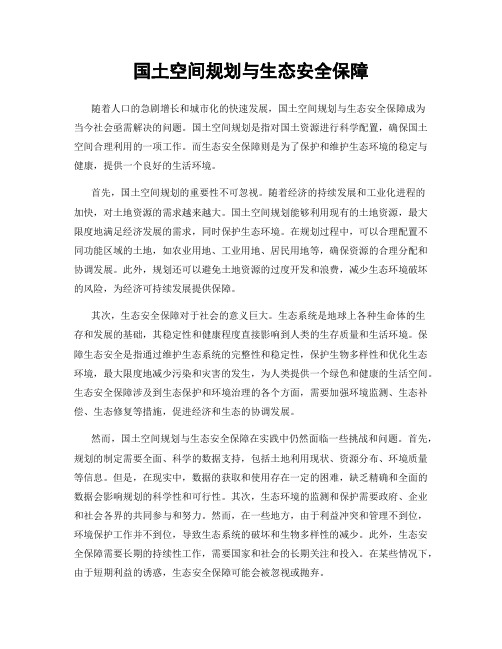
国土空间规划与生态安全保障随着人口的急剧增长和城市化的快速发展,国土空间规划与生态安全保障成为当今社会亟需解决的问题。
国土空间规划是指对国土资源进行科学配置,确保国土空间合理利用的一项工作。
而生态安全保障则是为了保护和维护生态环境的稳定与健康,提供一个良好的生活环境。
首先,国土空间规划的重要性不可忽视。
随着经济的持续发展和工业化进程的加快,对土地资源的需求越来越大。
国土空间规划能够利用现有的土地资源,最大限度地满足经济发展的需求,同时保护生态环境。
在规划过程中,可以合理配置不同功能区域的土地,如农业用地、工业用地、居民用地等,确保资源的合理分配和协调发展。
此外,规划还可以避免土地资源的过度开发和浪费,减少生态环境破坏的风险,为经济可持续发展提供保障。
其次,生态安全保障对于社会的意义巨大。
生态系统是地球上各种生命体的生存和发展的基础,其稳定性和健康程度直接影响到人类的生存质量和生活环境。
保障生态安全是指通过维护生态系统的完整性和稳定性,保护生物多样性和优化生态环境,最大限度地减少污染和灾害的发生,为人类提供一个绿色和健康的生活空间。
生态安全保障涉及到生态保护和环境治理的各个方面,需要加强环境监测、生态补偿、生态修复等措施,促进经济和生态的协调发展。
然而,国土空间规划与生态安全保障在实践中仍然面临一些挑战和问题。
首先,规划的制定需要全面、科学的数据支持,包括土地利用现状、资源分布、环境质量等信息。
但是,在现实中,数据的获取和使用存在一定的困难,缺乏精确和全面的数据会影响规划的科学性和可行性。
其次,生态环境的监测和保护需要政府、企业和社会各界的共同参与和努力。
然而,在一些地方,由于利益冲突和管理不到位,环境保护工作并不到位,导致生态系统的破坏和生物多样性的减少。
此外,生态安全保障需要长期的持续性工作,需要国家和社会的长期关注和投入。
在某些情况下,由于短期利益的诱惑,生态安全保障可能会被忽视或抛弃。
为了解决这些问题,我们需要积极推进国土空间规划和生态安全保障工作。
环保部印发《全国生态功能区划(修编版)》
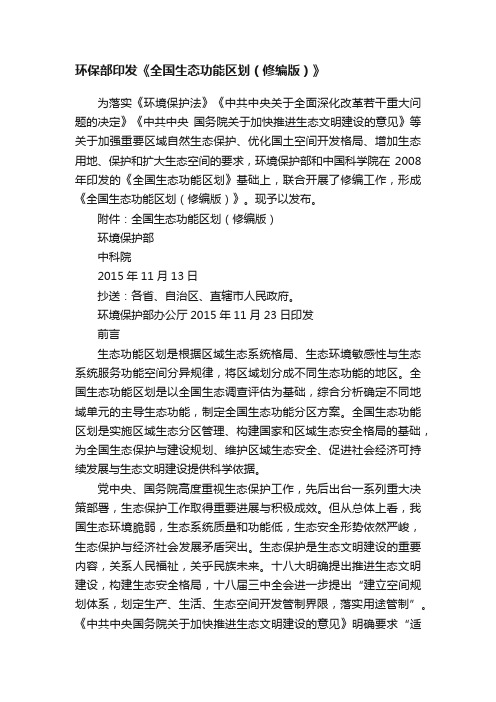
环保部印发《全国生态功能区划(修编版)》为落实《环境保护法》《中共中央关于全面深化改革若干重大问题的决定》《中共中央国务院关于加快推进生态文明建设的意见》等关于加强重要区域自然生态保护、优化国土空间开发格局、增加生态用地、保护和扩大生态空间的要求,环境保护部和中国科学院在2008年印发的《全国生态功能区划》基础上,联合开展了修编工作,形成《全国生态功能区划(修编版)》。
现予以发布。
附件:全国生态功能区划(修编版)环境保护部中科院2015年11月13日抄送:各省、自治区、直辖市人民政府。
环境保护部办公厅2015年11月23日印发前言生态功能区划是根据区域生态系统格局、生态环境敏感性与生态系统服务功能空间分异规律,将区域划分成不同生态功能的地区。
全国生态功能区划是以全国生态调查评估为基础,综合分析确定不同地域单元的主导生态功能,制定全国生态功能分区方案。
全国生态功能区划是实施区域生态分区管理、构建国家和区域生态安全格局的基础,为全国生态保护与建设规划、维护区域生态安全、促进社会经济可持续发展与生态文明建设提供科学依据。
党中央、国务院高度重视生态保护工作,先后出台一系列重大决策部署,生态保护工作取得重要进展与积极成效。
但从总体上看,我国生态环境脆弱,生态系统质量和功能低,生态安全形势依然严峻,生态保护与经济社会发展矛盾突出。
生态保护是生态文明建设的重要内容,关系人民福祉,关乎民族未来。
十八大明确提出推进生态文明建设,构建生态安全格局,十八届三中全会进一步提出“建立空间规划体系,划定生产、生活、生态空间开发管制界限,落实用途管制”。
《中共中央国务院关于加快推进生态文明建设的意见》明确要求“适当增加生活空间、生态用地,保护和扩大绿地、水域、湿地等生态空间”。
党和政府有关生态文明建设的一系列部署对进一步开展全国生态功能区划提出了新的要求。
环境保护部和中国科学院2008年发布的《全国生态功能区划》在生态保护工作中发挥了重要作用。
生态环境部关于实施“三线一单”生态环境分区管控的指导意见(试行)
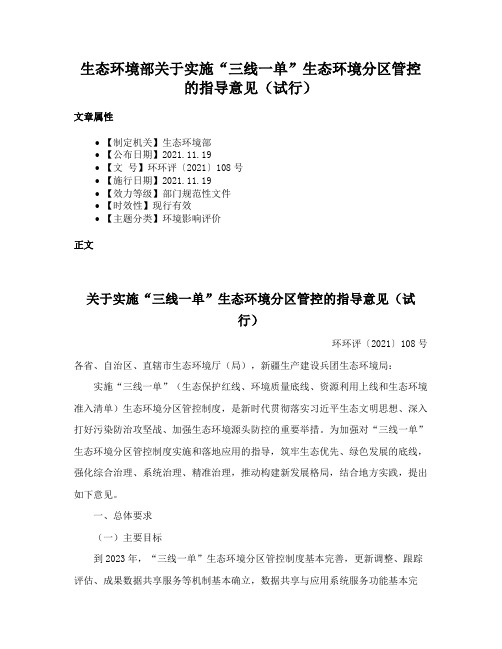
生态环境部关于实施“三线一单”生态环境分区管控的指导意见(试行)文章属性•【制定机关】生态环境部•【公布日期】2021.11.19•【文号】环环评〔2021〕108号•【施行日期】2021.11.19•【效力等级】部门规范性文件•【时效性】现行有效•【主题分类】环境影响评价正文关于实施“三线一单”生态环境分区管控的指导意见(试行)环环评〔2021〕108号各省、自治区、直辖市生态环境厅(局),新疆生产建设兵团生态环境局:实施“三线一单”(生态保护红线、环境质量底线、资源利用上线和生态环境准入清单)生态环境分区管控制度,是新时代贯彻落实习近平生态文明思想、深入打好污染防治攻坚战、加强生态环境源头防控的重要举措。
为加强对“三线一单”生态环境分区管控制度实施和落地应用的指导,筑牢生态优先、绿色发展的底线,强化综合治理、系统治理、精准治理,推动构建新发展格局,结合地方实践,提出如下意见。
一、总体要求(一)主要目标到2023年,“三线一单”生态环境分区管控制度基本完善,更新调整、跟踪评估、成果数据共享服务等机制基本确立,数据共享与应用系统服务功能基本完善,在规划编制、产业布局优化和转型升级、环境准入等领域的实施应用机制基本建立,推动生态环境高水平保护格局基本形成。
到2025年,“三线一单”生态环境分区管控技术体系、政策管理体系较为完善,数据共享与应用系统服务效能显著提升,应用领域不断拓展,应用机制更加有效,促进生态环境持续改善。
(二)基本原则系统管控,分类指导。
以环境管控单元为载体,系统集成空间布局约束、污染物排放管控、环境风险防控、资源利用效率等各项生态环境管控要求,对优先、重点、一般三类管控单元实施分区分类管理,提高生态环境管理系统化、精细化水平。
坚守底线,严格管理。
以生态功能不降低、环境质量不下降、资源环境承载能力不突破为底线,落实“三线一单”生态环境分区管控要求,坚决制止违反生态环境准入清单规定进行生产建设活动的行为,不断强化生态环境源头防控。
政治建设 生态文明建设分别的内容包括哪些

政治建设生态文明建设分别的内容包括哪些1,优化国土空间开发格局。
要按照人口资源环境相均衡、经济社会生态效益相统一的原则,控制开发强度,调整空间结构,促进生产空间集约高效、生活空间宜居适度、生态空间山清水秀,给自然留下更多修复空间,给农业留下更多良田,给子孙后代留下天蓝、地绿、水净的美好家园。
加快实施主体功能区战略,推动各地区严格按照主体功能定位发展,构建科学合理的城市化格局、农业发展格局、生态安全格局。
提高海洋资源开发能力,坚决维护国家海洋权益,建设海洋强国。
2,生态制度文明。
生态制度,是指以保护和建设生态环境为中心,调整人与生态环境关系的制度规范的总称。
生态制度文明,是生态环境保护和建设水平、生态环境保护制度规范建设的成果,它体现了人与自然和谐相处、共同发展的关系,反映了生态环境保护的水平,也是生态环境保护事业健康发展的根本保障。
生态环境保护和建设的水平,是生态制度文明的外化,是衡量生态制度文明程度的标尺。
3,加强生态文明制度建设。
要把资源消耗、环境损害、生态效益纳入经济社会发展评价体系,建立体现生态文明要求的目标体系、考核办法、奖惩机制。
建立国土空间开发保护制度,完善最严格的耕地保护制度、水资源管理制度、环境保护制度。
深化资源性产品价格和税费改革,建立反映市场供求和资源稀缺程度、体现生态价值和代际补偿的资源有偿使用制度和生态补偿制度。
加强环境监管,健全生态环境保护责任追究制度和环境损害赔偿制度。
加强生态文明宣传教育,增强全民节约意识、环保意识、生态意识,形成合理消费的社会风尚,营造爱护生态环境的良好风气。
4,生态意识文明。
思想意识是要解决人们的世界观、方法论与价值观问题,其中最重要的是价值观念与思维方式,它指导人们的行动。
以生态科学群、可持续发展理论和绿色技术群为代表的生态文明观,主要包括以下三个方面的内容:树立人与自然同存共荣、天人合一的自然观;建立社会、经济、自然相协调,可持续的发展观;选择健康、适度消费的生活观。
全域土地综合整治的深刻意义
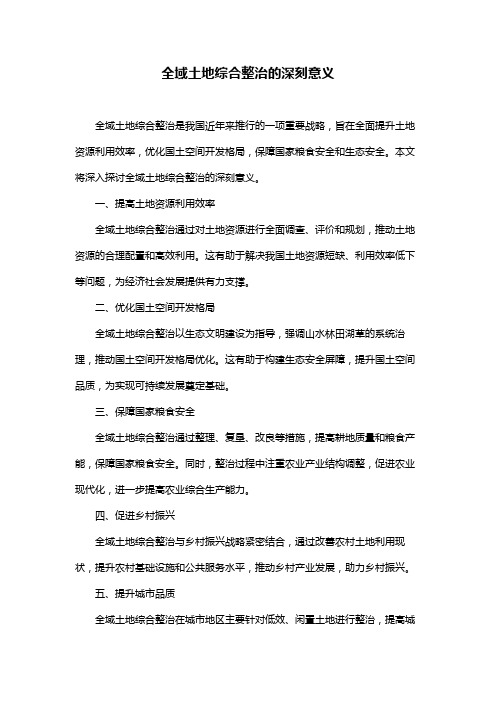
全域土地综合整治的深刻意义全域土地综合整治是我国近年来推行的一项重要战略,旨在全面提升土地资源利用效率,优化国土空间开发格局,保障国家粮食安全和生态安全。
本文将深入探讨全域土地综合整治的深刻意义。
一、提高土地资源利用效率全域土地综合整治通过对土地资源进行全面调查、评价和规划,推动土地资源的合理配置和高效利用。
这有助于解决我国土地资源短缺、利用效率低下等问题,为经济社会发展提供有力支撑。
二、优化国土空间开发格局全域土地综合整治以生态文明建设为指导,强调山水林田湖草的系统治理,推动国土空间开发格局优化。
这有助于构建生态安全屏障,提升国土空间品质,为实现可持续发展奠定基础。
三、保障国家粮食安全全域土地综合整治通过整理、复垦、改良等措施,提高耕地质量和粮食产能,保障国家粮食安全。
同时,整治过程中注重农业产业结构调整,促进农业现代化,进一步提高农业综合生产能力。
四、促进乡村振兴全域土地综合整治与乡村振兴战略紧密结合,通过改善农村土地利用现状,提升农村基础设施和公共服务水平,推动乡村产业发展,助力乡村振兴。
五、提升城市品质全域土地综合整治在城市地区主要针对低效、闲置土地进行整治,提高城市土地利用率,优化城市空间布局,提升城市品质和综合竞争力。
六、强化生态环境保护全域土地综合整治强调生态环境保护,通过退耕还林还草、水土保持、污染土壤修复等措施,提升生态系统服务功能,维护生物多样性,促进人与自然和谐共生。
七、推动区域协调发展全域土地综合整治注重区域间的协同发展,通过优化资源配置、基础设施互联互通、产业协同发展等手段,缩小区域发展差距,推动全国范围内的区域协调发展。
八、提升国土空间治理能力全域土地综合整治是国土空间治理的重要手段,有助于提升国土空间治理能力,实现治理体系现代化。
通过整治,我国国土空间治理将更加科学、精细、高效,为全面建设社会主义现代化国家提供有力保障。
总之,全域土地综合整治对于我国经济社会发展具有重要意义。
优化国土空间开发格局

46两会特别报道热点话题□ 本刊记者 刘芯邑全国政协委员、环保部南京环境科学研究所所长高吉喜:优化国土空间开发格局“今后十几年是我国工业化城镇化快速推进的重要时期,也是国土空间结构调整的重要时期。
”全国政协委员、环境保护部南京环境科学研究所所长高吉喜接受《民生周刊》记者采访时表示。
高吉喜分析,近几十年来,由于高强度开发和产业布局不尽合理,部分地区的经济社会发展规模已经超出了资源环境承载能力,所以引发了一系列生态环境问题,突出表现在土地退化、生物多样性下降、生态系统服务功能降低等。
他强调,通过控制开发强度,调整空间结构,促进生产空间集约高效、生活空间宜居适度、生态空间亦山清水秀,能给自然留下更多修复空间。
我国国土面积虽很大,但适宜居住和发展的空间并不大,山地多,平原少,适宜工业和城市建设及耕作的土地仅有180多万平方公里。
加之,生态脆弱区域面积广大,中度以上生态脆弱区域占全国国土面积的一半以上,脆弱的生态环境,使大规模、高强度的工业化、城镇化开发只能在有限的国土空间展开。
此外,我国各地经济开发的生产力要素也均存在较大空间差异,造成当前国土空间开发的产业布局和产业构成不尽合理,资源与能源的浪费和低效率现象普遍存在。
高吉喜进一步解释道,2010年12月21日,国务院正式出台了《全国主体功能区规划》,将我国国土空间分为优化开发区域、重点开发区域、限制开发区域和禁止开发区域。
四大主体功能区总体上基于不同区域的资源环境承载能力、现有开发强度和未来发展潜力所划分的,但由于划分尺度大,远不能满足现实需要。
高吉喜认为,既要满足人口增加、人民生活改善、经济发展、基础设施建设对国土空间的巨大需求,又要为了保障粮食安全而保护耕地,还需保障生态安全和人民健康。
必须建立与包括资源、环境在内的生态相适宜的产业结构和布局,这是优化我国国土空间开发格局的关键。
为此,高吉喜建议,根据生态适宜性,进一步划定我国国土开发总体布局。
应根据各地自然资源状况和生态适应性布局产业结构,充分考虑我国国土面积广阔、自然资源种类齐全的优势,以资源禀赋为前提,加大产业结构布局调整,推进形成产业生态适宜性分区,提高资源利用效率和效益,优化国土空间开发布局,逐步实现产业与资源供给和需求相适应的开发格局,形成资源节约、结构合理、环境友好的发展模式。
优化国土空间开发格局深入推进生态文明建设
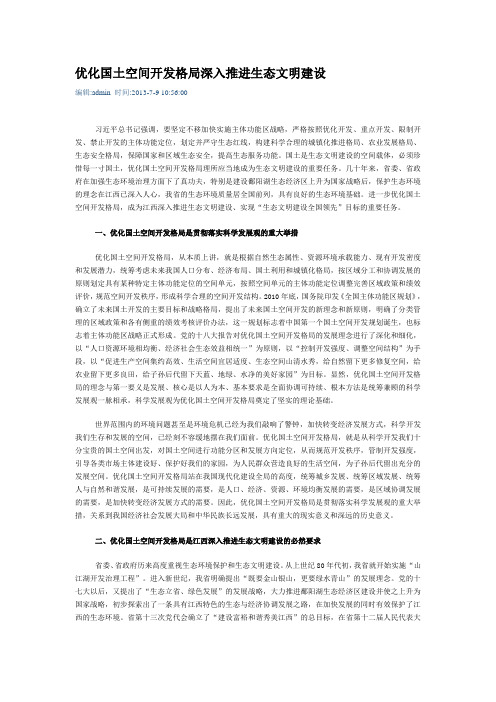
优化国土空间开发格局深入推进生态文明建设编辑:admin 时间:2013-7-9 10:56:00习近平总书记强调,要坚定不移加快实施主体功能区战略,严格按照优化开发、重点开发、限制开发、禁止开发的主体功能定位,划定并严守生态红线,构建科学合理的城镇化推进格局、农业发展格局、生态安全格局,保障国家和区域生态安全,提高生态服务功能。
国土是生态文明建设的空间载体,必须珍惜每一寸国土,优化国土空间开发格局理所应当地成为生态文明建设的重要任务。
几十年来,省委、省政府在加强生态环境治理方面下了真功夫,特别是建设鄱阳湖生态经济区上升为国家战略后,保护生态环境的理念在江西已深入人心,我省的生态环境质量居全国前列,具有良好的生态环境基础。
进一步优化国土空间开发格局,成为江西深入推进生态文明建设、实现“生态文明建设全国领先”目标的重要任务。
一、优化国土空间开发格局是贯彻落实科学发展观的重大举措优化国土空间开发格局,从本质上讲,就是根据自然生态属性、资源环境承载能力、现有开发密度和发展潜力,统筹考虑未来我国人口分布、经济布局、国土利用和城镇化格局,按区域分工和协调发展的原则划定具有某种特定主体功能定位的空间单元,按照空间单元的主体功能定位调整完善区域政策和绩效评价,规范空间开发秩序,形成科学合理的空间开发结构。
2010年底,国务院印发《全国主体功能区规划》,确立了未来国土开发的主要目标和战略格局,提出了未来国土空间开发的新理念和新原则,明确了分类管理的区域政策和各有侧重的绩效考核评价办法,这一规划标志着中国第一个国土空间开发规划诞生,也标志着主体功能区战略正式形成。
党的十八大报告对优化国土空间开发格局的发展理念进行了深化和细化,以“人口资源环境相均衡、经济社会生态效益相统一”为原则,以“控制开发强度、调整空间结构”为手段,以“促进生产空间集约高效、生活空间宜居适度、生态空间山清水秀,给自然留下更多修复空间,给农业留下更多良田,给子孙后代留下天蓝、地绿、水净的美好家园”为目标。
优化生态文明国土空间布局实施方案

04
创新发展
采用先进的科技手段和理念,创 新国土空间布局模式,推动生态
文明建设的可持续发展。
重点任务
生态红线划定
明确生态红线区域,严格保护重要生 态功能区和自然保护区,确保其生态 功能的完整性和稳定性。
资源节约利用
在资源开发利用过程中,应注重资源 的节约和循环利用,提高资源利用效 率,减少对生态环境的影响。
城镇空间布局
优化城镇发展格局
根据资源环境承载能力和经济社会发展需要 ,优化城镇发展格局,推动大中小城市和小 城镇协调发展。
提高城镇综合承载能力
加强城市基础设施建设,提高城市的服务功能和综 合承载能力,吸引人口和产业向城镇集聚。
促进城乡一体化发展
通过统筹城乡规划、基础设施、公共服务等 方面的发展,促进城乡一体化发展,缩小城 乡差距。
优化国土空间布局是生态文明建设的重要内容,是加快形成绿色生产方式和生活方式、推进生态文明 建设、实现高质量发展的必然要求。
目标概述
构建科学合理的空间格局
明确国土空间开发保护重点, 划定生态保护红线、永久基本 农田、城镇开发边界等空间管 控线,优化各类国土空间用途 ,强化空间用途管制。
提高生态保护和修复水平
优化生态文明国土空间布局 实施方案
汇报人:XXX
汇报时间:
• 方案背景与目标 • 优化原则与重点任务 • 空间布局方案 • 保障措施与建议 • 实施效果评估 • 结论与展望 • 参考文献
01
方案背景与目标
背景介绍
我国生态文明建设进入了关键期、攻坚期和窗口期,必须采取更有针对性的措施,协同推进降碳、减 污、扩绿、增长,推进生态优先、集约节约、绿色低碳发展,努力形成人与自然和谐共生的现代化建 设新格局。
国土空间治理目标

国土空间治理的目标是实现国土空间的高效、可持续和公平利用,促进经济社会的可持续发展。
具体来说,国土空间治理的目标包括以下几个方面:优化国土空间开发格局。
通过调整和优化土地利用结构,推进土地利用方式由粗放型向集约型转变,提高国土空间利用效率和效益。
促进生态保护和修复。
通过加强生态保护和修复,改善生态环境质量,保障国家生态安全。
推进城乡一体化发展。
通过优化城乡空间布局,促进城乡要素流动和区域协调发展,缩小城乡发展差距。
保障资源安全。
通过加强国土资源管理,保障国土空间内的自然资源、能源和矿产等资源的安全和可持续利用。
促进民生福祉。
通过推进国土空间规划和城市更新改造,改善人居环境和生活质量,提高人民群众的获得感和幸福感。
为了实现这些目标,需要采取一系列措施,包括加强法规建设、完善政策体系、强化技术支撑等。
同时,也需要各级政府、社会各界共同努力,共同推进国土空间治理工作的开展。
国土空间规划视角下的生态安全格局构建研究

国土空间规划视角下的生态安全格局构建研究发布时间:2023-01-31T06:50:15.728Z 来源:《建筑创作》2022年第16期作者:綦连明周伟[导读] 随着我国社会经济的快速发展綦连明周伟东营市自然资源和规划局垦利分局山东东营257500摘要:随着我国社会经济的快速发展,政府部门对自然资源的使用也提出了新的要求。
特别是在生态文明建设工作开展后,我国更加注重生态环境的保护与修复,并致力于提高生态效益与经济效益。
这就要求各级政府部门按照相关政策要求尽快完成新的国土空间规划,从而实现自然资源利用、开发、保护、整治等各个环节的提质增效。
但从实际情况来看,国土空间规划的综合整治与生态修复方面仍然存在机制不健全、规范性文件较少等问题。
在此背景下,本文围绕我国国土空间规划中综合整治与生态修复工作的优化路径展开深入分析。
关键词:生态安全格局;生态功能区;生态敏感区引言国土空间规划是我国对国土进行合理开发的重要手段,其风险可以提高我国对国土的综合利用率还可以进一步实现,对国土的科学治理,提升国家对国土的宏观调控效果。
从国土空间规划的应用来分析,在应用过程中要严格把握国家发展规划的风向标,以我国国土空间的划分为基础,在构建规划体系的过程中还要注意不同地区的专项规划和区域规划,将具有地区特色的专项规划作为规划体系的支撑内容。
国土空间规划具有清晰边界、精准定位、可以实现功能互补等特点,是我国空间发展的重要指南,可以帮助我国构建国土空间可持续发展的蓝图。
1国土空间规划背景及意义随着我国城市化发展速度日益加快,生态环境受到一定程度的影响,为保证居民宜居环境,维护生态系统平衡,则需要采取有效的改造和整治措施。
而国土空间规划作为一项关系到国计民生的重要活动,能够保证各项资源得到最大化利用,避免出现资源浪费等问题。
通过合理设计国土空间规划能够在实施生态改造的过程中,减少对自然环境的干扰和破坏,并对污染现象实施整治。
因此开展国土空间规划有利于支撑城市化及城镇化的快速发展,高效保护和利用国土空间资源。
“三区三线”的概念及内涵
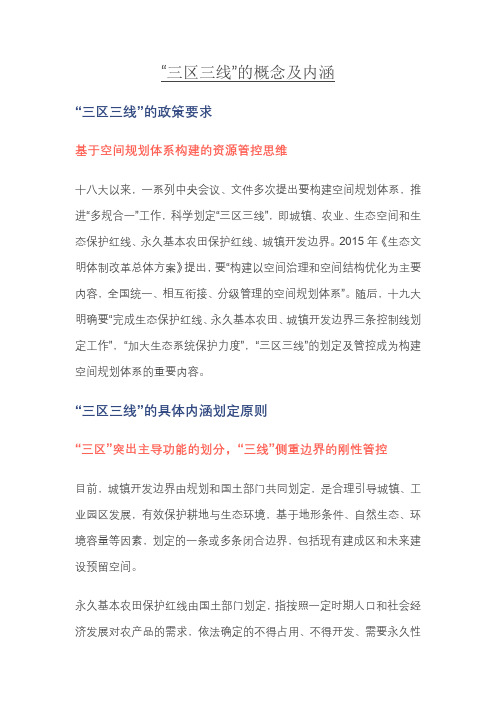
“三区三线”的政策要求基于空间规划体系构建的资源管控思维十八大以来,一系列中央会议、文件多次提出要构建空间规划体系,推进“多规合一”工作,科学划定“三区三线”,即城镇、农业、生态空间和生态保护红线、永久基本农田保护红线、城镇开发边界。
2015年《生态文明体制改革总体方案》提出,要“构建以空间治理和空间结构优化为主要内容,全国统一、相互衔接、分级管理的空间规划体系”。
随后,十九大明确要“完成生态保护红线、永久基本农田、城镇开发边界三条控制线划定工作”,“加大生态系统保护力度”,“三区三线”的划定及管控成为构建空间规划体系的重要内容。
“三区三线”的具体内涵划定原则“三区”突出主导功能的划分,“三线”侧重边界的刚性管控目前,城镇开发边界由规划和国土部门共同划定,是合理引导城镇、工业园区发展,有效保护耕地与生态环境,基于地形条件、自然生态、环境容量等因素,划定的一条或多条闭合边界,包括现有建成区和未来建设预留空间。
永久基本农田保护红线由国土部门划定,指按照一定时期人口和社会经济发展对农产品的需求,依法确定的不得占用、不得开发、需要永久性保护的耕地空间边界。
生态保护红线由环保部门划定,是在生态空间范围内具有特殊重要生态功能、必须强制性严格保护的区域,是保障和维护国家生态安全的底线和生命线。
“三线”由三个部门各自划定,空间重叠不可避免,未来从自然资源统一管控的角度,由自然资源部门统一划定将成为趋势。
“三区”的城镇空间指以城镇居民生产生活为主体功能的国土空间,包括城镇建设空间和工矿建设空间,以及部分乡级政府驻地的开发建设空间。
农业空间指以农业生产和农村居民生活为主体功能,承担农产品生产和农村生活功能的国土空间,主要包括永久基本农田、一般农田等农业生产用地以及村庄等农村生活用地。
生态空间指具有自然属性、以提供生态服务或生态产品为主体功能的国土空间,包括森林、草原、湿地、河流、湖泊、滩涂、荒地、荒漠等。
国内省市的不断实践国内省市的不断实践近两年,国务院和住建部分别下发了《省级空间规划试点方案》、《关于城市总体规划编制试点的指导意见》,宁夏、海南、沈阳、长春、南京、江苏、浙江等26个试点省市以及北京、上海等完成总规审批的城市,均在探索“三区三线”的划定。
国土空间规划指南最新版

国土空间规划指南最新版引言:国土空间规划是一个全面、系统、科学的规划过程,旨在合理配置和利用国土空间资源,促进经济社会可持续发展。
随着经济社会的不断发展和人民生活水平的不断提高,国土空间规划的重要性日益凸显。
为了更好地指导国土空间规划工作,特制定本指南。
一、指导思想坚持以人民为中心的发展思想,树立和践行绿水青山就是金山银山的理念,统筹经济社会发展和国土空间保护,实现人与自然和谐共生。
二、总体要求1.坚持生态优先、绿色发展。
科学评估国土空间开发适宜性,严格控制开发强度和范围,保护生态空间和生态功能。
2.坚持集约节约、高效利用。
提高国土空间资源利用效率,盘活存量资源,优化开发布局。
3.坚持保护传承、人文传统。
保护历史文化遗产,传承地域文化特色,塑造区域人文魅力。
4.坚持统筹城乡、协调发展。
缩小城乡区域差距,促进城乡要素合理流动和基本公共服务均等化。
三、重点任务1.完善国土空间规划体系。
建立国家、省、市、县四级规划衔接协调机制,形成上下贯通、横向协调的规划体系。
2.优化国土空间开发格局。
坚持节约优先,划定城镇开发边界,严格控制农用地非农化。
3.健全生态安全格局。
构建生态安全屏障,划定永久基本农田和生态保护红线,保护重要生态功能区。
4.加强城乡统筹发展。
优化城镇空间布局,规范村庄建设,实现城乡规划有序衔接。
5.强化规划实施保障。
建立规划实施监测评估机制,加大国土空间规划执法监督力度。
四、组织实施各级政府要高度重视国土空间规划工作,建立健全工作机制,落实规划编制、实施、监督等各环节的责任,加强部门协调配合,动员社会力量广泛参与,确保规划顺利实施。
结语:国土空间规划关系国家发展全局,事关经济社会可持续发展。
让我们紧密团结在以习近平同志为核心的党中央周围,按照新时代新要求,科学编制实施国土空间规划,为美丽中国建设贡献智慧和力量。
优化国土空间开发格局 促进资源节约集约利用

(接上页)度保障“阳光政务”运行规范化、常态化。
四是通过多种渠道和形式,加大宣传力度,扩大“阳光政务”影响,发挥更大的效用。
同时,要注意收集各方面反馈意见和建议,不断调整、完善和改进。
进一步加强系统干部队伍自身建设。
新形势、新使命、新任务,要求我们必须有更加坚定的信心、更加务实的作风、更加昂扬的精神状态,为各项任务落实提供保证。
一是进一步改进工作作风。
认真贯彻落实中央关于改进工作作风、密切联系群众八项规定,改革文风会风,发言之有物、管用的文件,开目的明确、真正解决问题的会议,力戒空话套话;改进调查研究,走出机关、走到一线、深入群众,用脚步丈量民情;坚持实干兴邦,真正把工作当作事业,立说立行、善作善成,始终保持奋发有为、昂扬向上的精神状态。
二是践行公平正义核心价值观。
公平正义集中体现了人力社保工作的价值取向。
全系统同志必须牢固树立、自觉践行。
无论是设计制度还是推进改革,都要着眼于使广大群众平等获得发展机会,调动和激发各类社会成员的创业创新活力。
要切实解决好老百姓关心的现实问题,多替弱势群体着想,多为弱势群体呼吁,推动改革发展成果惠及全省人民。
三是坚守廉洁从政底线。
党员干部要自觉加强党性修养,严格依法行政,敬畏权力、敬畏法纪、敬畏良心,始终保持清正廉洁的政治本色。
要以近年来系统内发生的违纪违法案件为反面教材,深入开展警示教育和从政道德教育,切实做到反腐倡廉常抓不懈、拒腐防变警钟长鸣。
要结合工作实际,深入推进惩防体系建设,完善管权、管事、管人各项制度,进一步预防各类腐败风险。
优化国土空间开发格局促进资源节约集约利用□浙江省国土资源厅厅长楼小东2012年,全省国土资源系统认真学习贯彻党的十八大、省第十三次党代会精神,紧紧围绕建设物质富裕精神富有现代化浙江总体目标,认真落实省委、省政府和国土资源部各项决策部署,持续深入推进“双保双服务”行动,全面深化重点领域改革创新,着力破解国土资源保障保护难题,为促进我省经济社会平稳健康发展提供了有力的资源保障和要素支撑。
加强生态文明建设筑牢祖国北疆生态安全屏障

气候变化是全球面临的重大问
题,提高内蒙古适应气候变化能力要 从全社会、全领域的视角探索整个区 域的应对气候变化问题。才能得到更 好的成效。减缓温室气体排放涉及到 经济社会的许多领域。通过优化经济 结构、加快工业升级、促进节能降耗、
《大小兴安岭林区生态保护与经济转
型规划(201 0—2020年)>。
3加大重点湿地保护与恢复力度。
我区地处干旱和半干旱地区,生态
环境非常脆弱,受气候变化影响很大。 气候变暖和极端气候事件的增多,对森 林、草原和湿地等自然生态环境系统、 生物多样性、农牧业生产都将产生一定 程度的不利影响或威胁,温度升高还将 加剧部分地区的水资源紧张状况。平衡
总面积13.2亿亩。占全国草原面积的 22%。居我国五大草原之首。现有林地
构建我国北方重要生态安全屏障优化国土空间开发格局加大自然生态系统和环境保护力度推进生态综合治理全面促进资源节约推动资源利用方式根本转变提高资源利用效率和效益建立可持续的生产方式产业结构发展方式和消费模式着力推进绿色发展循环发展低碳发展为推进生态文明建设转变发展方式促进社会和谐提供重要保障
加强生态文明建设筑牢祖国 北疆生态安全屏障
生态环境治理责任。 (六)认真落实主体功能区规划 按照<内蒙古自治区主体功能区规划》
(2009年一2020年)。针对国家和自治区确 定的限制开发区,实施“减轻压力、休养生 息”的方针,建立水源涵养型、防风固沙型、
水土保持型和生物多样性保护型等重要生
态功能保护区。在矿产资源开发中。要以科 学发展观为指导,严格依据地域生态主体 功能区的划分对矿产资源开发科学规划、 合理布局。根据资源环境的承载能力、现有
资金投入与补偿的方针、政策进行统一协
调,科学确定生态环境补偿标准、补偿方式
我国国土空间的“三大战略格局”
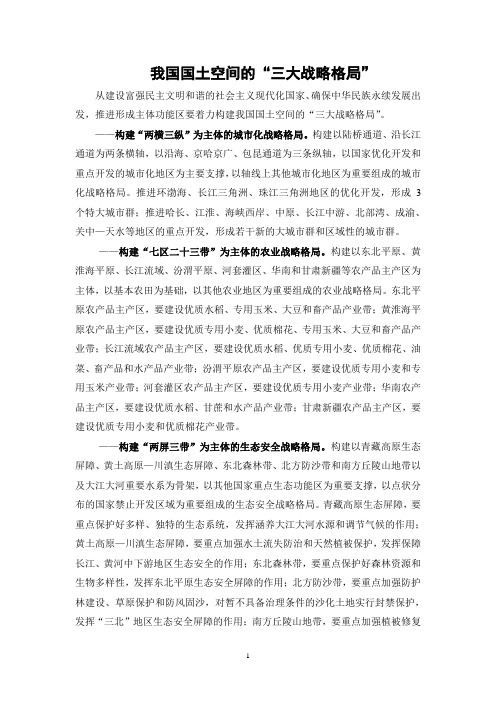
我国国土空间的“三大战略格局”从建设富强民主文明和谐的社会主义现代化国家、确保中华民族永续发展出发,推进形成主体功能区要着力构建我国国土空间的“三大战略格局”。
——构建“两横三纵”为主体的城市化战略格局。
构建以陆桥通道、沿长江通道为两条横轴,以沿海、京哈京广、包昆通道为三条纵轴,以国家优化开发和重点开发的城市化地区为主要支撑,以轴线上其他城市化地区为重要组成的城市化战略格局。
推进环渤海、长江三角洲、珠江三角洲地区的优化开发,形成3个特大城市群;推进哈长、江淮、海峡西岸、中原、长江中游、北部湾、成渝、关中—天水等地区的重点开发,形成若干新的大城市群和区域性的城市群。
——构建“七区二十三带”为主体的农业战略格局。
构建以东北平原、黄淮海平原、长江流域、汾渭平原、河套灌区、华南和甘肃新疆等农产品主产区为主体,以基本农田为基础,以其他农业地区为重要组成的农业战略格局。
东北平原农产品主产区,要建设优质水稻、专用玉米、大豆和畜产品产业带;黄淮海平原农产品主产区,要建设优质专用小麦、优质棉花、专用玉米、大豆和畜产品产业带;长江流域农产品主产区,要建设优质水稻、优质专用小麦、优质棉花、油菜、畜产品和水产品产业带;汾渭平原农产品主产区,要建设优质专用小麦和专用玉米产业带;河套灌区农产品主产区,要建设优质专用小麦产业带;华南农产品主产区,要建设优质水稻、甘蔗和水产品产业带;甘肃新疆农产品主产区,要建设优质专用小麦和优质棉花产业带。
——构建“两屏三带”为主体的生态安全战略格局。
构建以青藏高原生态屏障、黄土高原—川滇生态屏障、东北森林带、北方防沙带和南方丘陵山地带以及大江大河重要水系为骨架,以其他国家重点生态功能区为重要支撑,以点状分布的国家禁止开发区域为重要组成的生态安全战略格局。
青藏高原生态屏障,要重点保护好多样、独特的生态系统,发挥涵养大江大河水源和调节气候的作用;黄土高原—川滇生态屏障,要重点加强水土流失防治和天然植被保护,发挥保障长江、黄河中下游地区生态安全的作用;东北森林带,要重点保护好森林资源和生物多样性,发挥东北平原生态安全屏障的作用;北方防沙带,要重点加强防护林建设、草原保护和防风固沙,对暂不具备治理条件的沙化土地实行封禁保护,发挥“三北”地区生态安全屏障的作用;南方丘陵山地带,要重点加强植被修复和水土流失防治,发挥华南和西南地区生态安全屏障的作用。
优化国土空间开发保护格局实施方案
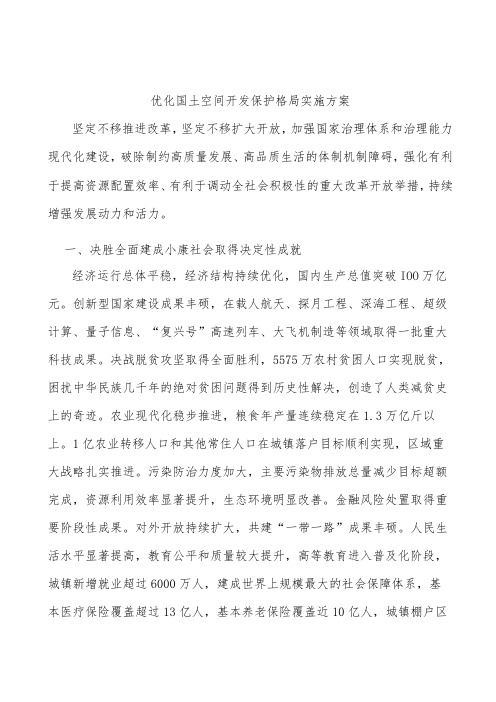
优化国土空间开发保护格局实施方案坚定不移推进改革,坚定不移扩大开放,加强国家治理体系和治理能力现代化建设,破除制约高质量发展、高品质生活的体制机制障碍,强化有利于提高资源配置效率、有利于调动全社会积极性的重大改革开放举措,持续增强发展动力和活力。
一、决胜全面建成小康社会取得决定性成就经济运行总体平稳,经济结构持续优化,国内生产总值突破IOO万亿元。
创新型国家建设成果丰硕,在载人航天、探月工程、深海工程、超级计算、量子信息、“复兴号”高速列车、大飞机制造等领域取得一批重大科技成果。
决战脱贫攻坚取得全面胜利,5575万农村贫困人口实现脱贫,困扰中华民族几千年的绝对贫困问题得到历史性解决,创造了人类减贫史上的奇迹。
农业现代化稳步推进,粮食年产量连续稳定在1.3万亿斤以上。
1亿农业转移人口和其他常住人口在城镇落户目标顺利实现,区域重大战略扎实推进。
污染防治力度加大,主要污染物排放总量减少目标超额完成,资源利用效率显著提升,生态环境明显改善。
金融风险处置取得重要阶段性成果。
对外开放持续扩大,共建“一带一路”成果丰硕。
人民生活水平显著提高,教育公平和质量较大提升,高等教育进入普及化阶段,城镇新增就业超过6000万人,建成世界上规模最大的社会保障体系,基本医疗保险覆盖超过13亿人,基本养老保险覆盖近10亿人,城镇棚户区住房改造开工超过2300万套。
新冠肺炎疫情防控取得重大战略成果,应对突发事件能力和水平大幅提高。
公共文化服务水平不断提高,文化事业和文化产业繁荣发展。
国防和军队建设水平大幅提升,军队组织形态实现重大变革。
国家安全全面加强,社会保持和谐稳定。
“十三五”规划目标任务胜利完成,我国经济实力、科技实力、综合国力和人民生活水平跃上新的大台阶,全面建成小康社会取得伟大历史性成就,中华民族伟大复兴向前迈出了新的一大步,社会主义中国以更加雄伟的身姿屹立于世界东方。
二、积极拓展海洋经济发展空间坚持陆海统筹、人海和谐、合作共赢,协同推进海洋生态保护、海洋经济发展和海洋权益维护,加快建设海洋强国。
浅谈国土空间规划与生态环境优化的关系

浅谈国土空间规划与生态环境优化的关系发布时间:2021-06-29T09:31:49.778Z 来源:《新型城镇化》2021年6期作者:于丽蓉[导读] 要深入分析并明确国土空间规划对生态环境具体功能以生态文明为前提,提高国土空间规划效果。
广西壮族自治区自然资源生态修复中心摘要:在社会经济高速发展的背景下,人们深刻认识到生态保护对经济发展的重要作用。
高度重视生态环境建设,提高国土空间规划的整体效果,探究国土空间规划与生态环境保护的内在联系,运用科学高效的措施加强生态环境建设,为评估资源和环境可持续空间和空间规划提供重要的参考。
在科学空间规划中,也能够促进当地的自然条件和生产要素有机融合,满足人与国家关系的和谐健康发展。
关键词:国土空间规划;生态环境优化;关系引言在社会快速发展的背景下,人民群众对生活质量要求也在不断提高,高度重视对国土空间规划的全面控制,满足经济发展需要。
在工业经济高速发展的背景下,各种环境问题不断突出,国土空间资源规划建设需要重点加强对生态环境的可持续保护,高度重视对国土空间资源的协调,统筹规划,调整环境与自然之间的内在联系才能提高社会经济发展的整体质量,满足社会发展的实际需求,要深入分析并明确国土空间规划对生态环境具体功能以生态文明为前提,提高国土空间规划效果。
1国土空间规划科学内涵规划能够满足社会公共利益的发展需求,确保社会经济环境资源的长远发展为未来的系统化战略制定提供相对合理依据的空间规划,能够以空间为对象,对空间资源进行合理保护、开发、利用、修复与整治。
国土空间规划关键核心是构建空间保护的内在关联,确保空间数量、质量、结构、强度发生明显变化。
空间规划不单是控制性的规划,而是要符合空间未来的长远发展。
2以生态文明为前提的国土空间规划2.1设立生态视角探索生态文明新模式在社会经济高度发展的背景下,人与自然之间的关系已经成为社会发展的重要内容,在生态文明观点中需要加强对空间规划控制的策略,通过总体规划确保在框架内进行通过实施生态战略,对生态文明创新机制进行一系列的开发与研究,确保整合资源协调发展。
- 1、下载文档前请自行甄别文档内容的完整性,平台不提供额外的编辑、内容补充、找答案等附加服务。
- 2、"仅部分预览"的文档,不可在线预览部分如存在完整性等问题,可反馈申请退款(可完整预览的文档不适用该条件!)。
- 3、如文档侵犯您的权益,请联系客服反馈,我们会尽快为您处理(人工客服工作时间:9:00-18:30)。
生态安全格局与国土空间开发格局优化2012年11月8日,举世瞩目的中国共产党第十八次全国代表大会(以下简称十八大)在北京召开。
此次大会工作报告的重要内容之一是非常具体而专业地表述了国土空间开发格局在生态文明建设中的意义,并使用了“生态安全格局”这样的专业词汇,明确提出其在优化国土空间开发格局中的地位:“国土是生态文明建设的空间载体,必须珍惜每一寸国土。
要按照人口资源环境相均衡、经济社会生态效益相统一的原则,控制开发强度,调整空间结构,促进生产空间集约高效、生活空间宜居适度、生态空间山清水秀,给自然留下更多修复空间,给农业留下更多良田,给子孙后代留下天蓝、地绿、水净的美好家园。
加快实施主体功能区战略,推动各地区严格按照主体功能定位发展,构建科学合理的城市化格局、农业发展格局、生态安全格局。
”一年之后,2013年11月12日,中国共产党第十八届中央委员会第三次全体会议进一步提出“加快生态文明制度建设”,并指出应“建立空间规划体系,划定生产、生活、生态空间开发管制界限,落实用途管制。
健全能源、水、土地节约集约使用制度”,并具体提出应“划定生态保护红线,坚定不移实施主体功能区制度,建立国土空间开发保护制度,严格按照主体功能区定位推动发展。
”这其中涉及三个核心概念:国土利用的空间格局(包括城镇化格局、农业生产格局和生态安全格局)、生态红线和主体功能区。
这三个概念明确了将国土作为生态文明建设空间载体的定位。
而这其中有一个关键的学术概念“格局”,尤其是“生态安全格局”。
生态安全格局的概念最早于1995年提出,是景观安全格局的一种。
景观安全格局的精髓是把景观中的水平过程(包括雨洪过程、火灾蔓延、动物迁徙、城市扩张、农业开垦等)作为竞争性的空间控制和土地覆盖过程来理解,它们必须有效地克服空间阻力来完成这样的空间覆盖。
换句话说,要维护某种过程的安全和健康,必须占据一个关键性的格局,这个格局就称为景观安全格局。
景观安全格局研究主要针对中国国土和城市规划建设中面临的重大问题:紧张的人地关系问题,即保护和开发这两类基本的水平空间过程。
在这两大类格局之下,可以细分为多种竞争性的控制和覆盖过程,形成包括农业用地、工业用地、城市建设用地、旅游用地等用地类型的格局。
正如围棋中的“金角、银边、草肚皮”所描绘的,无论对白方或黑方来说,占据“角”和“边”这样的空间位置都至关重要。
城镇化格局、农业生产格局、生态安全格局有时是互不相干的,但更多情况下是重叠的,如平原滨水地带,它们既是农业的高产地带,也是城镇建设的关键地段,更是保障生态安全的关键地段。
必须强调的是,与围棋博弈不同的是,这场格局间主编 俞孔坚译 萨拉·雅各布斯 张健的博弈不是非赢即输,而是以平衡与和谐为目标的多赢博弈。
其理论支点是博弈论关于平衡点或者安全点的研究—事实上,安全格局概念本身最初也是受到了博弈论中的“安全点”的启发。
生态安全格局是维护生态过程(如雨洪过程、动物栖息地和迁徙等)的安全和健康的关键性格局,即空间意义上的生态底线,或称为生态红线。
由于生态过程在当今快速的城镇化过程中总是处于劣势,因此,确定生态安全格局、划定生态底线(生态红线)就显得格外重要,除了其科学的意义之外,还有环境伦理的意义。
相仿,农业用地在中国的城镇化过程中也极易被侵噬,因此,耕地保护红线也至关重要。
好在中国政府对粮食问题一直较为关注,所以有了“18亿亩耕地保护红线”的概念—这一数据的准确性暂且不论—但相对于生态安全格局来说,农业生产格局的保护要受重视得多。
真正使生态安全格局被提升到今天这样高度的是十八大之后新一届政府的认识水平。
过去30年的城市扩张带来的一系列生态安全危机日渐凸显,特别是近年来的城市洪涝问题日益严峻,生态危机已经成为危及人类生存的问题。
但相较于农业生产格局,生态安全格局或生态底线空间的研究、规划和管理等则相对滞后得多。
过去30多年,尽管在达成三个格局的和谐方面,我们已经失去了许多机会,但所谓“亡羊补牢,未为晚矣”,今天来推动关于生态安全格局和生态基础设施的研究仍然具有重要意义。
而且,中国的经验将为其他发展中国家及早开展国土生态安全格局研究,以及协调生产、生活与生态三个格局提供借鉴。
ECOLOGICAL SECURITY PATTERN AND SPATIAL DEVELOPMENT PATTERN OPTIMIZATIONOF NATIONAL TERRITORYCHIEF EDITOR Kongjian YUTRANSLATED BY Sara JACOBS Angus ZHANG On November 8, 2012, the Eighteenth National Congress of the Communist Party of China was heldin Beijing. One of the most important topics of this congress meeting was to convey the significanceof territorial development on ecological civilization construction. Terms such as “Ecological SecurityPattern” were used, along with intentions to optimize national spatial development pattern. “It is ingeographical space that ecological civilization can be advanced, and we must cherish every bit of it.Guided by the principle of maintaining balance between population, resources and the environment andpromoting economic, social and ecological benefits, we should keep the pace of development undercontrol and regulate its spatial composition. We should ensure that the space for production is usedintensively and efficiently, that the living space is livable and proper in size, and that the ecologicalspace is unspoiled and beautiful; and we should leave more space for nature to achieve self-renewal. Weshould keep more farmland for farmers, and leave to our future generations a beautiful homeland withgreen fields, clean water and a blue sky. We should ensure the speedy implementation of the functionalzoning strategy and require all regions to pursue development in strict accordance with this strategy, andadvance urbanization, agricultural development and ecological security in a scientific and balanced way.”One year later, on November 12, 2013, the Third Plenary Session of the Eighteenth CentralCommittee of the Communist Party of China further defined the strategy to speed up systems buildingto promote ecological civilization progress by calling for the establishment of a spatial planning systemthat would designate the control limits in spatial development in production, life and ecology. The sameplanning system would be used to implement land use regulations for the economical use of energy,water, and land. Specifically, the Central Committee called for “delimiting a redline for ecologicalprotection; firmly implementing functional zoning system; establishing protection system of nationalspatial development; progressing the development in strict accordance of functional zone positioning.”There are three concepts at work here: 1) spatial pattern of land uses, including urbanization,agricultural, and ecological patterns, 2) ecological redline, and 3) functional zones. Together, theseconcepts illustrate how land is the spatial foundation for ecological civilization construction. Still, themost important academic concept to understand is that of “pattern,” specifically, “ Ecological SecurityPatterns.”The concept of Ecological Security Pattern was first introduced in 1995 as a type of LandscapeSecurity Pattern, which was developed as a framework for treating horizontal landscape processes,such as stormwater management, fire control, animal migrations, urban expansion, and agriculturalreclamation as active spatial land processes. These processes seek to maximize their spatial coveragethrough overcoming spatial limitations and resistances. In other words, to maintain the safety and healthof a landscape process, the key patterns at work must be identified beforehand. These came to be knownas “Landscape Security Patterns.” The studies of Landscape Security Patterns focuses on the human-environment relationship in China’s territorial development and urban growth. The tension betweenprotection and development creates various competitive control and coverage processes, seen in theprotection and development of agricultural land, industrial land, urban land, and tourism land.As in Go game, it is critical to occupy as much space in the corners and edges of the board aspossible. The planning and management of urbanization patterns, agricultural patterns, and ecologicalsecurity patterns are pieces in a Go game of national territory. The different patterns can be unrelated,but more often are overlapped. Waterfront plain areas, for example, have potential to be high-yield agricultural land as well as spaces for urban construction and ecological protection. It must beemphasized however that this is not a win-or-lose game, but seeks balance and harmony — in fact, thetheoretical foundation in the game of landscape security patterns is that of Game Theory and securitypoints.Ecological Security Patterns play a pivotal role in maintaining ongoing ecological processes such asstormwater management, animal habitat and migration. In a physical sense, it is the ecological bottomline (red line) of territorial land. In the context of rapid urbanization, ecological processes are oftenpushed towards a disadvantaged position. It is important to establish ecological security patterns as away to mark the ecological bottom line. In addition to maintaining the scientific importance of theselandscapes, marking the ecological bottom line helps establish an environmental site ethics. Agriculturalland also faces similar challenges, thus making the agricultural redline equally important. Fortunately,the Chinese central government pays close attention to grain issues, going as far as establishing a “1.8billion Mu of agricultural land redline.” However, when compared with the ecological security pattern,agricultural protection is greater.The new government after the Eighteenth National Congress helped lift the concept of an ecologicalsecurity pattern into mainstream governmental work. The urban expansion of the past 30 years hasbrought about an ecological security crisis resulting in a question of survival. Compared with agriculturalsecurity pattern, the research, planning, and management of ecological security pattern have remainedlackluster. Although we may have lost lots of opportunities to achieve harmony among the three patterns,there is still room for ecological security patterns and ecological infrastructures. The experiences ofChina can help other developing countries to start early on ecological security pattern studies in order tocoordinate the three patterns of production, life and ecology.。
